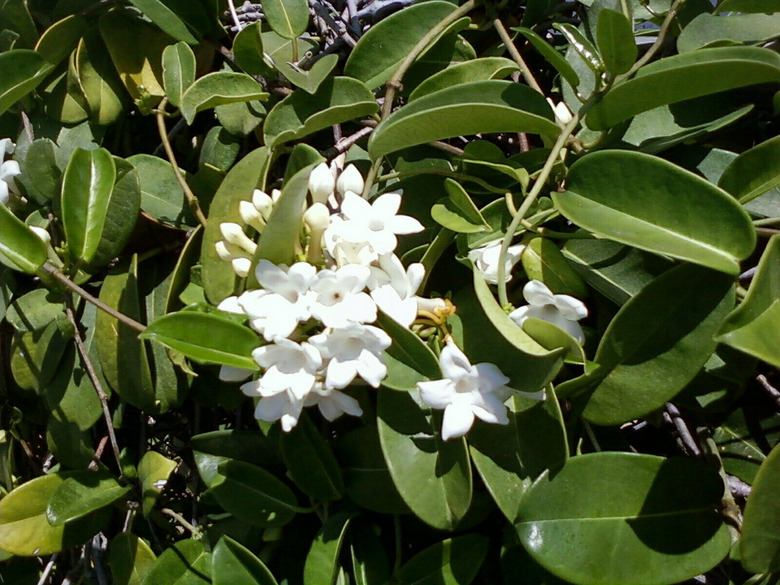How To Grow Stephanotis From Seeds
Things Needed
- Mature healthy stephanotis plant
- Seed starting mix
- Coarse sand
- Styrofoam egg carton
- Potting soil
- Coarse sand
- Clear plastic bag
- Plastic spray bottle
- 4-inch clay pots
- Organic compost
Tip
Don't worry about planting more than one of these beauties for the sake of pollination, as they don't need a buddy for that task.
Warning
Do not overfeed stephanotis. Too much fertilizer will result in profuse foliar growth, but the plant will stop flowering.
Stephanotis, often referred to as Madagascan jasmine, is a handsome, fast-growing tropical and subtropical vine. It sports large elliptical, leathery dark green leaves, and a profusion of delicate, highly-fragrant pristine white flowers from spring through fall. It is winter hardy in all temperate areas of the United States, is easy to grow and not demanding. The plant prefers rich, well-draining soil in full sun and it loves humidity. Healthy adult plants produce very large 5-6 inch long green seed pods that look like mangoes and take 6-9 months to mature. Your stephanotis will refuse to bloom while there are pods developing on it because producing offspring will consume all of the plant's energies. Picking pods as they appear will keep the plant in flowering condition.
- Stephanotis, often referred to as Madagascan jasmine, is a handsome, fast-growing tropical and subtropical vine.
- Your stephanotis will refuse to bloom while there are pods developing on it because producing offspring will consume all of the plant's energies.
Step 1
Pick the mature pod from the mother plant when it turns completely yellow. Put it in the leg of an old pair of pantyhose or a knee-high so that none of the seeds will float away. Set it in a clear plastic or glass container on a sunny windowsill until it puckers and splits open on its own.
Step 2
Remove the pod from the stocking and use a stout paring knife to peel away the thick layer of flesh, revealing a long, thin cylinder of seeds. This will look somewhat like a pine cone, with 50-100 seeds all layered tightly together like fish scales. They're stuck to a long wad of fine, soft white fibers. Each creamy colored seed will have a long, soft, thick fuzzy tail, kind of like a dandelion seed. Work in an area free of moving air so that the seeds won't float away from you.
- Pick the mature pod from the mother plant when it turns completely yellow.
- Remove the pod from the stocking and use a stout paring knife to peel away the thick layer of flesh, revealing a long, thin cylinder of seeds.
Step 3
Spread the stephanotis seeds out in a single layer on a cookie sheet, and set it in a warm, dry area where they'll be undisturbed overnight. This will ensure that all remaining moisture will evaporate from them, discouraging rot.
Step 4
Remove the lid of a Styrofoam egg carton. Poke a few drainage holes in the bottom of each cell to create a seed starting tray. Combine coarse sand with potting soil for a seed starting mix with 20 percent sand content, and fill the cells with it. Press a single seed lightly into the center of each cell. Just barely cover with a very thin layer of sand.
- Spread the stephanotis seeds out in a single layer on a cookie sheet, and set it in a warm, dry area where they'll be undisturbed overnight.
Step 5
Set the prepared seed starting pack in the egg carton lid, and water with gentle spritzing from a plastic spray bottle. The surface should be evenly moist, but take great care not to wet it to the point that it's soggy. Seal everything in a clear plastic bag to retain humidity, and place in a warm spot with plenty of indirect bright light. The top of your refrigerator or above a water heater are good choices.
Step 6
Check the planting medium daily to make sure that it doesn't dry out completely. Water only when it begins to feel slightly dry, but just enough to evenly moisten. The seeds will germinate in about 2 weeks, and produce seedlings in about another 2 weeks.
- Set the prepared seed starting pack in the egg carton lid, and water with gentle spritzing from a plastic spray bottle.
- Check the planting medium daily to make sure that it doesn't dry out completely.
Step 7
Use scissors or a paring knife to carefully separate each of the egg carton cells. Gently peel the Styrofoam from the seedling's rootball. Plant it in a well-draining 4-inch clay pot of the same mixture you started the seeds in. Spritz to water enough to evenly moisten the medium.
Step 8
Set the potted seedlings in a warm, bright spot for a couple of weeks, where they'll receive at least 6 hours of indirect sun each day. Don't allow the temperature to drop below 55 degrees F, and protect them from strong direct sunlight.
Step 9
Move the stephanotis seedlings outdoors when all danger of frost has passed. Feed their roots a layer of organic compost once a month throughout the growing season, and keep their medium evenly moist. They like their heads in the sun and their feet in the shade, and must be provided with excellent drainage. Your stephanotis seedlings will flower 2-3 years from the time they've sprouted.
- Use scissors or a paring knife to carefully separate each of the egg carton cells.
- Feed their roots a layer of organic compost once a month throughout the growing season, and keep their medium evenly moist.
